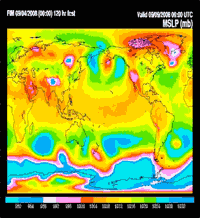ESRL Quarterly Newsletter
The ESRL quarterly newsletter provides highlights of ESRL's diverse research programs and explains how these are integrated to form a more complete understanding of our earth system.
ESRL Quarterly - Fall 2008 PDF
FIM Shapes Up

FIM (with the tongue-twisting title of Flow-following, finite-volume Icosahedral Model) is a global weather model under development at ESRL. The model’s unusual grid system makes it look like a soccer ball crafted from thousands of polygons, but researchers here hope it will soon improve the accuracy of operational forecasts.
Clamoring for Climate Help
Government insiders and outsiders spent three days in June reviewing NOAA’s developing plans for a National Climate Service, said Randall Dole, acting Deputy Director for Research at ESRL and one of several ESRL scientists involved. The reviewers urged NOAA to push forth with plans for an NCS, given growing demand for climate information from citizens, companies, natural resource managers, and others.
Director's Corner
-
By the Numbers: Science on a Sphere
Climate Program Report is Out
This fall, the U.S. Climate Change Science Program will complete a set of 21 reports on the causes and consequences of climate change in North America—a significant undertaking that relied on the commitment and expertise of ESRL scientists, said CCSP acting director William Brennan.
CSI: Climate Scene Investigation
In NOAA’s version of CSI, researchers investigate killer climate patterns such as heat waves, tornadoes, and floods.
Arctic Haze, by Plane and by Ship

ESRL scientists joined colleagues from around the world in a major initiative to better understand the Arctic’s polluted springtime atmosphere. Haze particles, which come from around the world and contain black carbon (soot) and other pollutants, may help explain why the North is warming more quickly than many expected.
ESRL Cultivates Young Scientists
“We need to bring new, talented young people into the workforce,” said Steve Koch, Directory and technical monitor for a new NOAA educational program called the Interdisciplinary Scientific Environmental Technology Cooperative Science Center (ISET).
Bleach Alert!
With NOAA’s Coral Reef Watch program, ESRL scientists have developed the new Experimental Seasonal Coral Bleaching Outlook Tool, to provide advance warning of warm-water events. Corals can recover from mild bleaching, especially if the reef ecosystem is generally healthy. With advance warning of potential temperature stress, decision makers can reduce other stressors, by limiting diving and fishing, removing coral predators, treating coral disease, or reducing coastal runoff.
Honors and Awards
In Brief
Sooty ships, California flooding, CIRA's new director and the AMS's 36th Conference on Broadcast Meteorology, Dan Endres returns and ASCOS/AMISA deploys
UAS Greenland

Two lightweight airplanes zigzagged over the surface of Greenland’s Jakobshavn glacier this summer–unpiloted–collecting data for researchers at CIRES and ESRL. Instruments onboard snapped photographs of glacial lakes and gathered altitude and depth information from areas otherwise inaccessible to scientists.
-
Publications List for Summer 2008
Fred Fehsenfeld Symposium
Scientists from around the world gathered at ESRL for two days in late September, to celebrate Fred Fehsenfeld’s 46 years of scientific achievement and leadership at NOAA. Fehsenfeld, who turns 74 in October, agreed to the celebration, he said, on one condition: “This is a celebration for us, not me.”
Sun-Powered Victory

In any normal cross-country car race, teams need to figure out when their vehicles are likely to run low on fuel, so they can set up pit stops. In a 2,400-mile solar race, the question is where the sun will shine brightly enough to power up solar cells. A University of Michigan team racing in the ninth annual North American Solar Challenge in July relied on data from GMD’s surface radiation (SURFRAD) network—and the team won.
